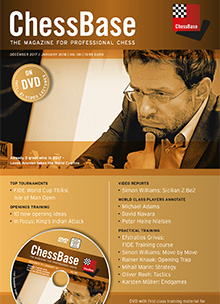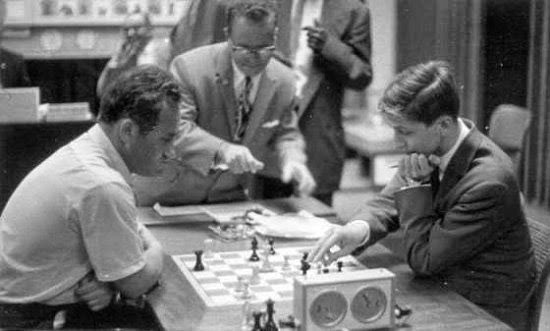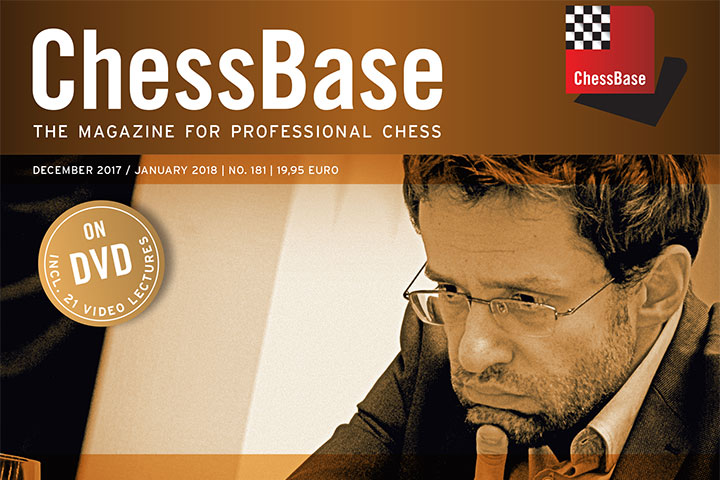The World Cup: Thrills and Spills
CBM 181 Review: Aronian marches on

• Languages: English, German
• Delivery: Download, Post
• Level: Any
• Price: €19.95. €16.76/$18.10 without VAT (for customers outside the EU)
World Cup Chess is a cross between a marathon and a gladiator contest. On the one hand you should have the pace and persistence of a long distance runner, on the other you should be able to beat back rivals closing in on you. However, it can be frustrating when you are not able to get past your pursuers. A major part of this issue is devoted to the World Cup that Aronian won only after a tense match with Ding Liren in the last round. Those who fell by the wayside included Vladimir Kramnik, Viswanathan Anand and Magnus Carlsen(world champions past and present), not to mention Vassily Ivanchuk, Vachier-Lagrave and last year’s finalists, Peter Svidler and Sergei Karjakin. The final round between Ding Liren and Aronian was hard-fought and the outcome was only determined in the play-off. The last game is annotated by Sagar shah and also explained in a video commentary by Daniel King in this issue. For the present review I have also checked what the players themselves have had to to say and subsequent findings by other experts.
Ding Liren - Levon Aronian, FIDE World Cup 2017
The Ragozin is being played by every top grandmaster in the world - it is time you also add it to your repertoire to get interesting and dynamic positions against 1. d4!
GM Alejandro Ramirez analyses every single move that White can play once the Ragozin is reached, but due to several transpositional possibilities he always emphasises strategic goals to keep in mind.
This issue also includes games from the Isle of Man Tournament won by Carlsen ahead of Nakamura and Anand. His second, Peter Heine Nielsen has annotated the key encounter, Caruana-Carlsen for this issue. For good measure this issue also has games from the European Team Championship won by Azerbaijan ahead of Russia among others.

An ecstatic Mamedyarov with other members of the Azerbaijan Team | Photo: EuroTeams2017.com
An unusual move in Slav Exchange
This brings me to other sections of this magazine. Apart from trademark sections on strategy, tactics and the endgame, there are 11 opening surveys ranging from the Sicilian to Slav. Among them I would single out the analysis of an unusual line in Slav Exchange (D10) by Alexey Kuzmin: 1.d4 d5 2.c4 c6 3. cxd5 cxd5 4.Bg5!?
The standard move is of course 4.Bf4. But the move here is not without merit. If Black plays 4...Nf6 White intends to disrupt his kingside with 5.Bxf6 gf6. However, it would offer Black compensation in the form of two bishops. Black can hold ...Nf6 in reserve and play 4...Nc6 or try 4...h6 and even the unorthodox 4...f6. An intriguing variation!
Classic Revisited
In the “Strategy” section Mihail Marin offers a discussion of attacking plans and finding difficult moves with quite a few celebrated examples. The best of them is the game, Fischer-Geller, Skopje 1967. Geller was one of the few players who had a plus score against Fischer (+5 -4 =2).

Geller vs Fischer, Curacao 1962 | Photo: via tabladeflandes.com
It figures as one of the three losses Bobby included in his classic, "My 60 Memorable Games". Over the years the game has seen commentary by Fischer, Geller and Kasparov, not to mention Edmar Mednis, Murey and Boleslavsky who have enriched our understanding with valuable analysis.
A Test for Young Readers
Marin has drawn our attention to quite a few phenomenal lines that might have arisen over the board. Here is just one of them. Black is a piece up, but faces a mating attack on h7 or g7. Desperate situations demand desperate remedies. So he offers the queen not only to quell the attack but also to set a minefield for his opponent.The challenge for young readers is to avoid the pitfalls and find a clear path to victory (solution at the end of this article).
When you examine this position in the context of the whole game in this issue, you, it’s only the tip pf the proverbial iceberg. There is more to it than meets the eye.
Click or tap the second game in the list to switch
There is much else in this DVD that deserves to be explored. In all there are 2075 OTB games of which 135 are annotated. The annotators include Michael Adams, Suat Atalik and Michal Krasenkow among others. A major contribution is made by Sagar Shah who has annotated 33 games.
More info. on this issue may be found here.
Recommended.
Enjoy the best moments of recent top tournaments (World Cup, Isle of Man Open) with analysis of top players. In addition you'll get lots of training material. For example 10 new suggestions for your opening repertoire.
Links


























